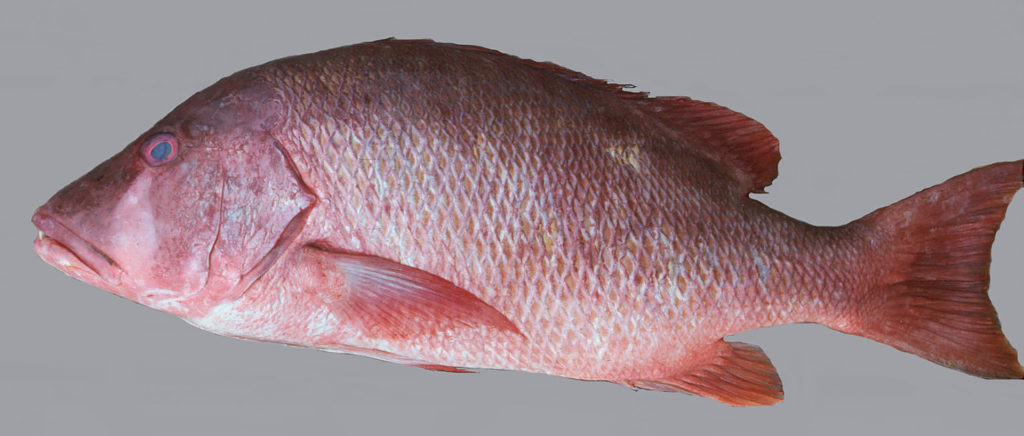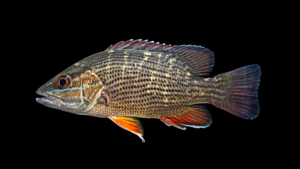
| Family | Scientific Name | Author | Year | Common Name |
| Lutjanidae | Lutjanus griseus | (Linnaeus) | 1758 | Gray Snapper |
Note: All Lutjanus — Soft dorsal and anal fins with scales. Dorsal fin with 10 or 12, rarely, 9, 11, or 13 spines, and 11-14, rarely 10 or 15, soft rays. Ectopterygoid teeth absent. Gill rakers, excluding rudiments, 16 or fewer, rarely 17, on lower limb of first gill arch. Caudal fin truncate, or nearly so, to moderately forked, lobes of fin not elongated.
LuLutjanus griseus
Unique Characters: Dorsal fin usually with 10 spines and 14 soft rays, rarely 9 or 11 spines and 13 or 15 soft rays. Dark spot below anterior part of soft dorsal fin present or absent. No large, pronounced black spot at base and in axil of pectoral fin. Dark spot below anterior part of soft dorsal fin present or absent. Anal fin rounded at all sizes, the middle rays less than half length of head. No dark spot below anterior part of soft dorsal fin. Vomerine tooth patch anchor-shaped, with a median posterior extension. Upper canines much larger than lower. Cheek scales in 6-9 (usually 7 or 8) rows. Pectoral-fin length about equal to distance from tip of snout to posterior edge of preopercle, 3.7-4.2 times in standard length. Body comparatively slender, greatest depth 2.6-3.2, usually 2.7-3.1, times in standard length.
Similar Species:
Cubera Snapper
Lutjanus cyanopterus
Schoolmaster Lutjanus apodus
Dog Snapper Lutjanus jocu
Cubera Snapper Lutjanus cyanopterus. Dorsal fin usually with 10 spines and 14 soft rays, rarely 9 or 11 spines and 13 or 15 soft rays. Dark spot below anterior part of soft dorsal fin present or absent. No large, pronounced black spot at base and in axil of pectoral fin. Dark spot below anterior part of soft dorsal fin present or absent. Anal fin rounded at all sizes, the middle rays less than half length of head. No dark spot below anterior part of soft dorsal fin. Vomerine tooth patch without a distinct posterior extension on median line. Upper and lower canines very strong, about equally developed; cheek scales in 8-10, usually 9, rows.
Schoolmaster Lutjanus apodus. Dorsal fin usually with 10 spines and 14 soft rays, rarely 9 or 11 spines and 13 or 15 soft rays. Dark spot below anterior part of soft dorsal fin present or absent. No large, pronounced black spot at base and in axil of pectoral fin. Dark spot below anterior part of soft dorsal fin present or absent.Anal fin rounded at all sizes, the middle rays less than half length of head. No dark spot below anterior part of soft dorsal fin. Vomerine tooth patch anchor-shaped, with a median posterior extension. Upper canines much larger than lower. Cheek scales in 6-9 (usually 7 or 8) rows. Pectoral-fin longer than distance from tip of snout to posterior edge of preopercle, 3.0-3.5 times in standard length (in L. apodus of 7-10 cm standard length pectoral-fin length approximately equal to that of L. griseus of similar size). Body comparatively deep, greatest depth 2.3-2.8, usually 2.4-2.7, times in standard length. Scales relatively large, transverse rows between upper edge of opercle and caudal-fin base 39-44, usually 40-43. Lateral-line scales 40-45. Scales above lateral line 5-7. No whitish bar below eye.
Dog Snapper Lutjanus jocu. Dorsal fin usually with 10 spines and 14 soft rays, rarely 9 or 11 spines and 13 or 15 soft rays. Dark spot below anterior part of soft dorsal fin present or absent. No large, pronounced black spot at base and in axil of pectoral fin. Dark spot below anterior part of soft dorsal fin present or absent. Anal fin rounded at all sizes, the middle rays less than half length of head. No dark spot below anterior part of soft dorsal fin. Vomerine tooth patch anchor-shaped, with a median posterior extension. Upper canines much larger than lower. Cheek scales in 6-9 (usually 7 or 8) rows. Pectoral-fin longer than distance from tip of snout to posterior edge of preopercle, 3.0-3.5 times in standard length. Body comparatively deep, greatest depth 2.3-2.8, usually 2.4-2.7, times in standard length. Scales of moderate size, transverse rows between upper edge of opercle and caudal-fin base 45-49, usually 46-48. Lateral-line scales 46-49. Scales above lateral line 8-11. A rather diffuse whitish bar below eye, not obvious in all preserved specimens.
Gallery








